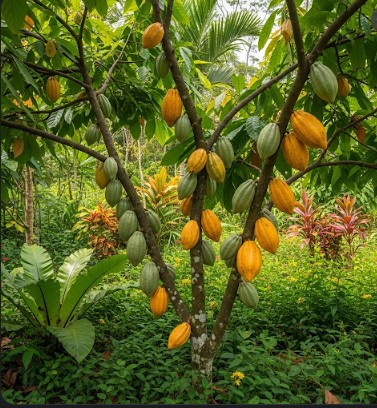
Many of us imagine vast, sun-drenched plantations when we think of cocoa. But what if you could have your own little chocolate factory right in your backyard? Growing cocoa at home is a unique and rewarding project that’s more accessible than you might think. With the right knowledge and a bit of patience, you can cultivate the Theobroma cacao tree and harvest your very own cocoa beans. While it’s a long-term commitment, the journey from seed to chocolate is an incredibly satisfying one.
The Ideal Climate for Cocoa
The Theobroma cacao tree is a true tropical plant. It thrives in warm, humid conditions and doesn’t tolerate cold temperatures. The ideal climate for growing cocoa at home involves a consistent temperature between 21°C and 32°C (70°F and 90°F). It also requires high humidity, so if you live in a drier area, you might need to mist the plant regularly or use a humidifier.
Cocoa trees grow naturally in the understory of rainforests, so they prefer a sheltered spot with partial shade. Direct, harsh sunlight can scorch their leaves, especially when they are young. A good location would be under a larger tree or on a patio where it gets morning sun but is protected from the intense afternoon heat. Remember, this is a long-term project; a cocoa tree can take several years to mature and produce pods.
Sourcing and Planting Your Cocoa Tree
The first step is to acquire either cocoa seeds or a small seedling. You can often find seeds or seedlings from specialized tropical plant nurseries. When planting, choose a rich, well-draining soil with a slightly acidic pH (between 5.0 and 6.5). If you’re growing in a container, select a pot with good drainage holes to prevent the roots from becoming waterlogged.
When you plant the seed or seedling, ensure the top of the root ball is level with the soil surface. Gently firm the soil around the base and give it a good watering. For seeds, plant them about an inch deep and keep the soil consistently moist. With proper care, your seedling will begin to grow, bringing you one step closer to your goal of growing cocoa at home.
Ongoing Care: Watering, Feeding, and Pruning
To keep your cocoa plant healthy, you need to follow a consistent care schedule. Water the plant regularly, ensuring the soil stays moist but not soggy. Fertilize every two to three weeks during the growing season with a balanced, liquid fertilizer. Pruning is also important to maintain the plant’s shape and to encourage better airflow, which helps prevent diseases.
Keep an eye out for common pests like capsid bugs and mealybugs. You can often manage these by regularly inspecting the leaves and using an organic insecticidal soap. A more serious issue is black pod disease, which can be identified by black spots on the pods. Remove any affected pods immediately to stop the spread of the disease.
Harvesting and Fermenting Your Beans
After several years, you’ll see your first cocoa pods. A ripe pod is typically a deep yellow, orange, or red color, depending on the variety. The pod will feel firm to the touch. To harvest, use a sharp knife or secateurs to cut the pod from the tree, being careful not to damage the branch.
Once harvested, crack open the pod to reveal the beans covered in a white pulp. This is where the magic happens! Fermentation is a crucial step that develops the chocolate’s flavor.
Place the beans and pulp in a container, cover it with a cloth, and let them ferment for about 5-7 days. During this time, turn the beans every couple of days. The temperature of the beans will rise, and the pulp will break down, leaving you with fermented beans ready for drying and roasting. This process is key to getting the rich flavor we all love and a great reward for your efforts of growing cocoa at home.
If you’d like to learn more about the complete process of turning cocoa beans into chocolate, you can find a wealth of information on this topic at the World Cocoa Foundation website.
References
- World Cocoa Foundation. “About Cocoa.” Available at: https://www.worldcocoafoundation.org/about-cocoa/
- Theobroma Cacao. (2024). In Wikipedia. Retrieved August 12, 2025, from https://en.wikipedia.org/wiki/Theobroma_cacao